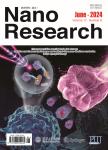Targeting orthotopic gliomas with renal-clearable luminescent gold nanoparticles
Targeting orthotopic gliomas with renal-clearable luminescent gold nanoparticles作者机构:Department of Chemistry and Biochemistry The University of Texas at Dallas Richardson TX 75080 USA Children's Research Institute Department of Pediatrics Department of Neuroscience Harold C. Simmons Comprehensive Cancer Center UT Southwestem Medical Center Dallas TX 75390 USA Simmons Cancer Center Annette G. Strauss Center for Neuro-Oncology Department of Internal Medicine Department of Neurology and Neurotherapeutics UT Southwestern Medical Center Dallas TX 75390 USA
出 版 物:《Nano Research》 (纳米研究(英文版))
年 卷 期:2017年第10卷第4期
页 面:1366-1376页
核心收录:
学科分类:0808[工学-电气工程] 0809[工学-电子科学与技术(可授工学、理学学位)] 07[理学] 0805[工学-材料科学与工程(可授工学、理学学位)] 0702[理学-物理学]
基 金:supported by CPRIT 美国国立卫生研究院(NIH)项目 fund from the University of Texas at Dallas to J. Z UTSW CRI start-up funds UTSW High Impact/High Risk Grant and NINDS K99/R00 to W. P. G
主 题:enhanced permeability and retention brain tumor passive targeting gold nanoparticles renal clearance
摘 要:A major clinical translational challenge in nanomedicine is the potential of toxicity associated with the uptake and long-term retention of non-degradable nanoparticles (NPs) in major organs. The development of inorganic NPs that undergo renal clearance could potentially resolve this significant biosafety concern. However, it remains unclear whether inorganic NPs that can be excreted by the kidneys remain capable of targeting tumors with poor permeability. Glioblastoma multiforme, the most malignant orthotopic brain tumor, presents a unique challenge for NP delivery because of the blood-brain barrier and robust blood-tumor barrier of reactive microglia and macroglia in the tumor microenvironment. Herein, we used an orthotopic murine glioma model to investigate the passive targeting of glutathione-coated gold nanoparticles (AuNPs) of 3 nm in diameter that undergo renal clearance and 18-nm AuNPs that fail to undergo renal clearance. Remarkably, we report that 3-nm AuNPs were able to target intracranial tumor tissues with higher efficiency (2.3× relative to surrounding non-tumor normal brain tissues) and greater specificity (3.0×) than did the larger AuNPs. Pharmacokinetics studies suggested that the higher glioma targeting ability of the 3-nm AuNPs may be attributed to the longer retention time in circulation. The total accumulation of the 3-nm AuNPs in major organs was significantly less (8.4×) than that of the 18-nm AuNPs. Microscopic imaging of blood vessels and renal-clearable AuNPs showed extravasation of NPs from the leaky blood-tumor barrier into the tumor interstitium. Taken together, our results suggest that the 3-nm AuNPs, characterized by enhanced permeability and retention, are able to target brain tumors and undergo renal clearance.



